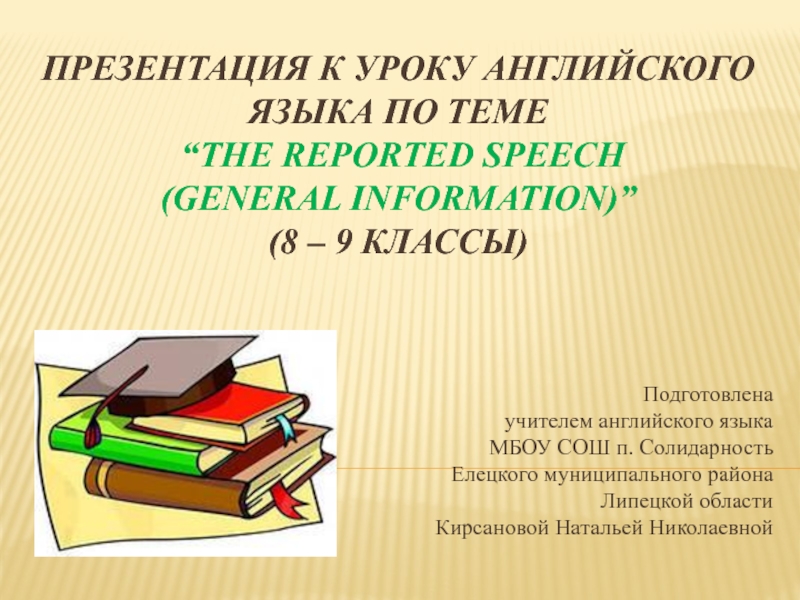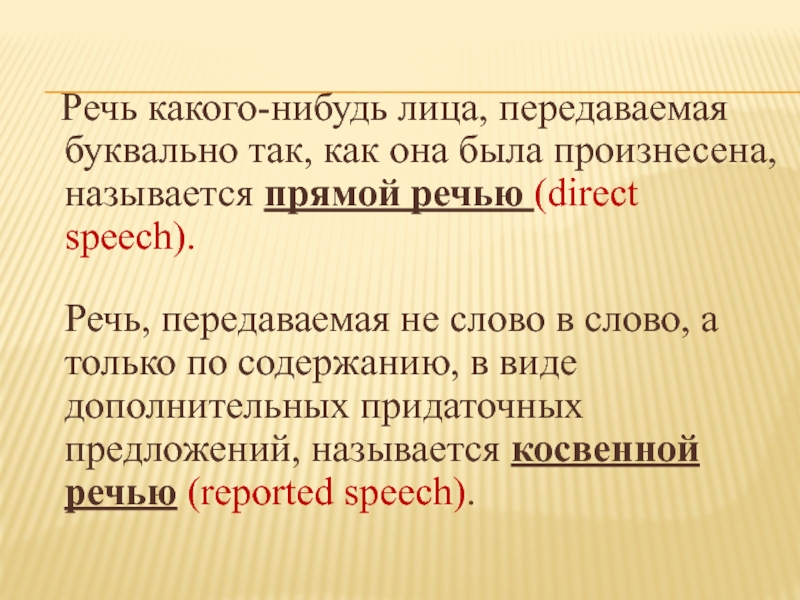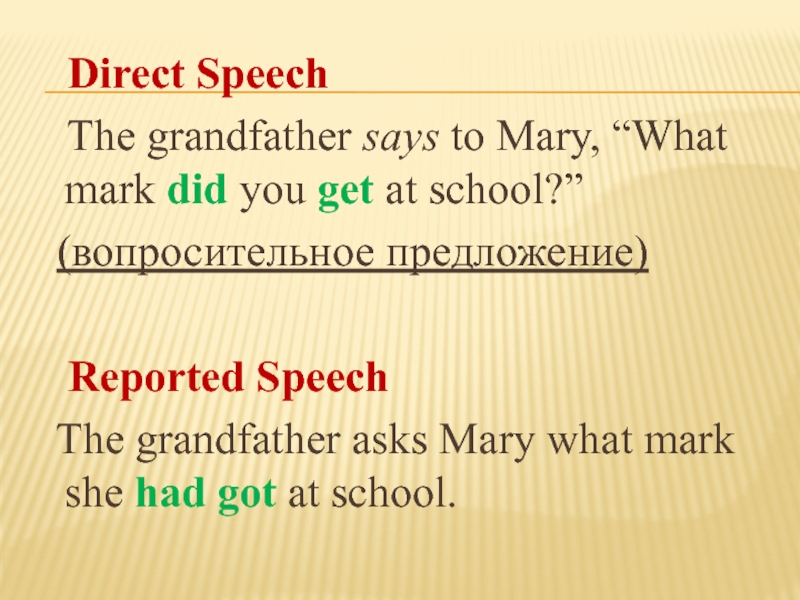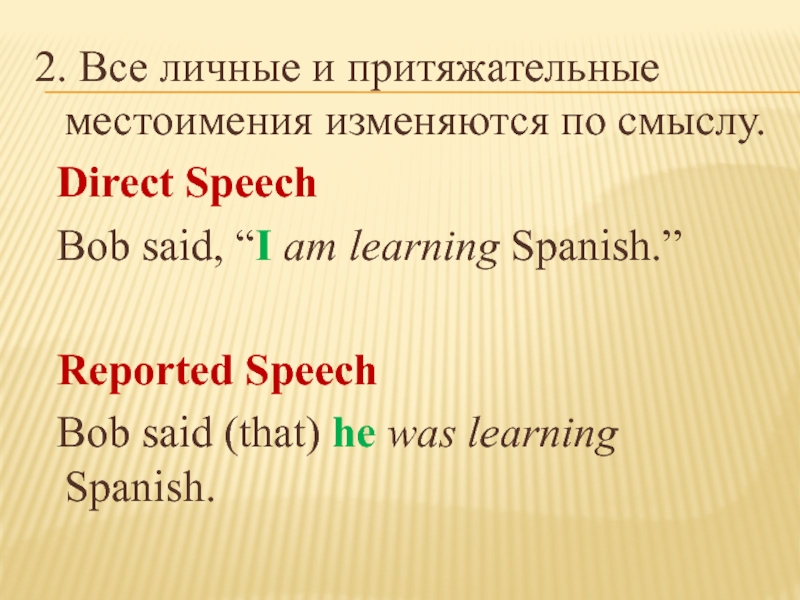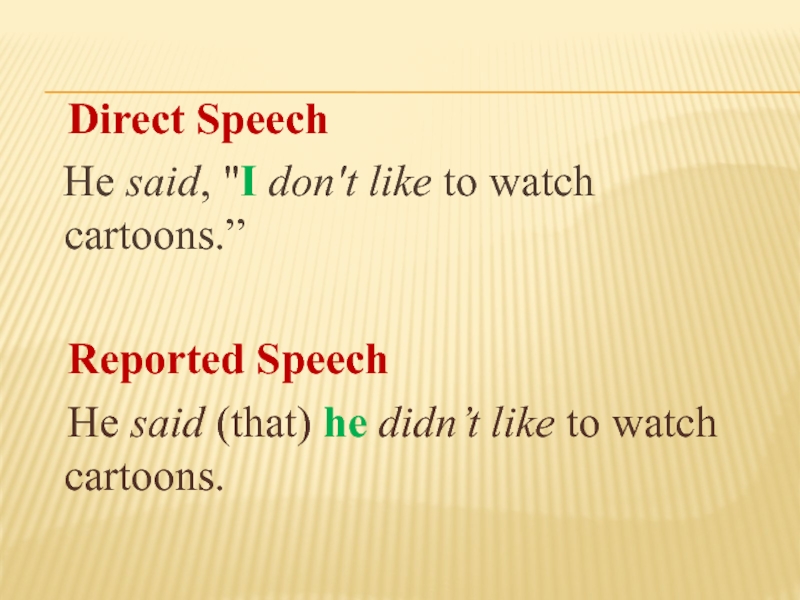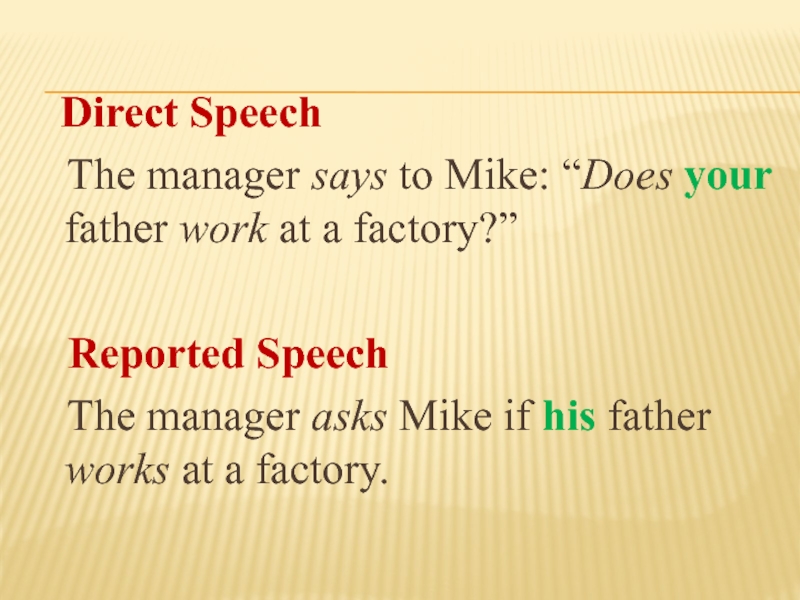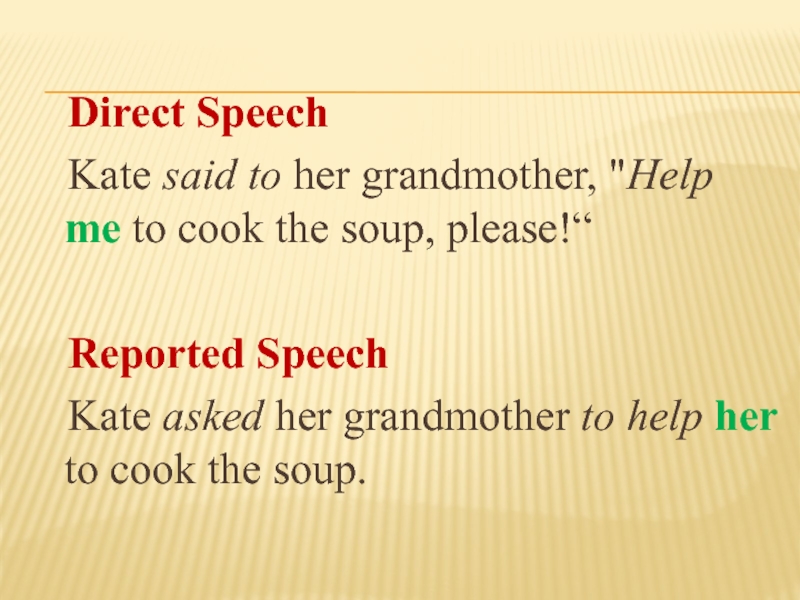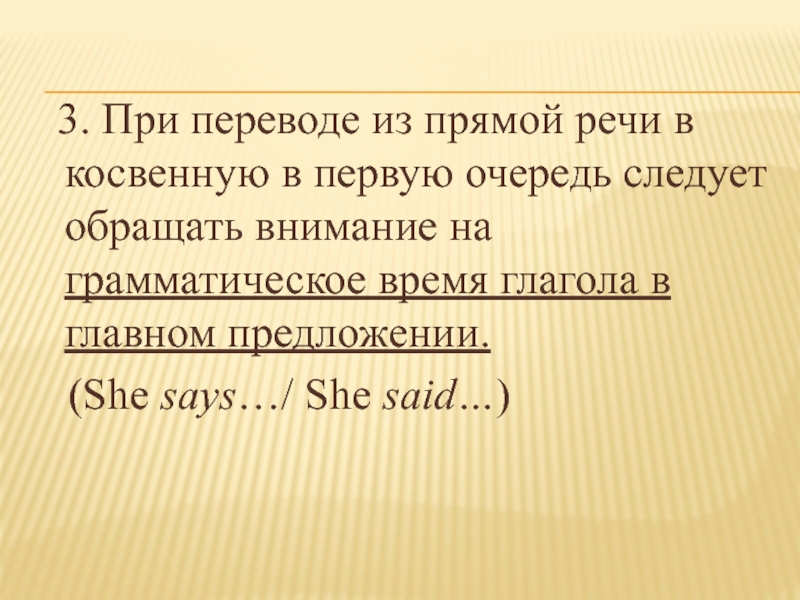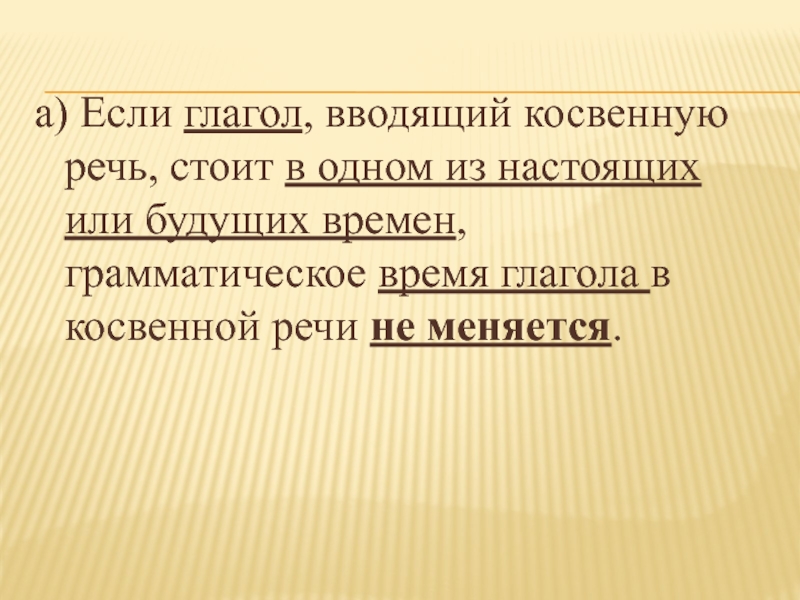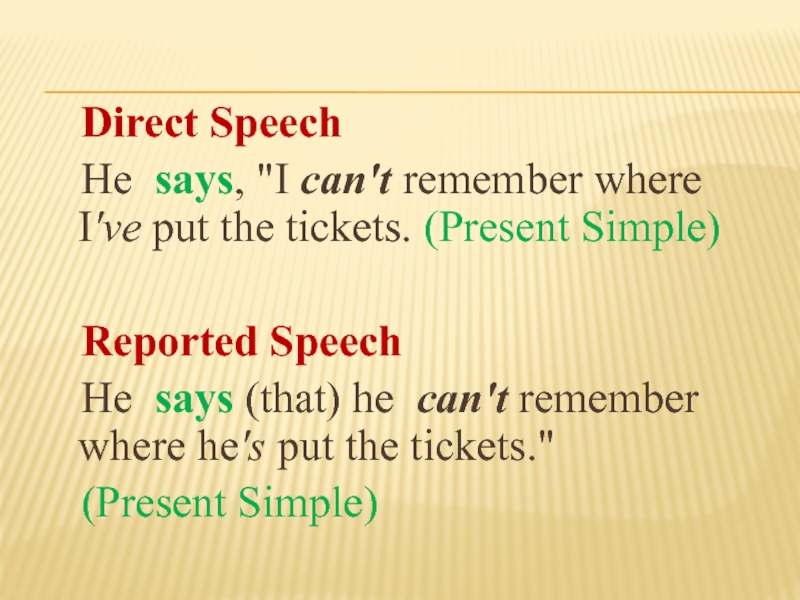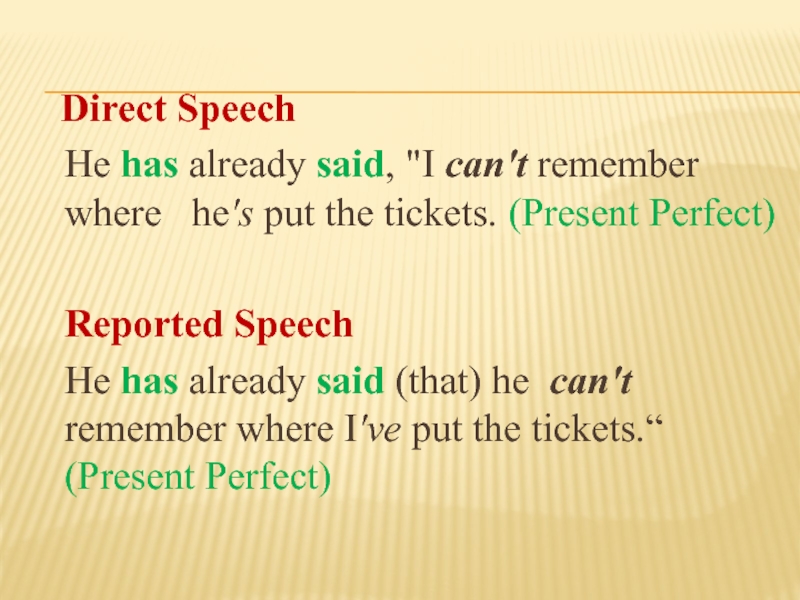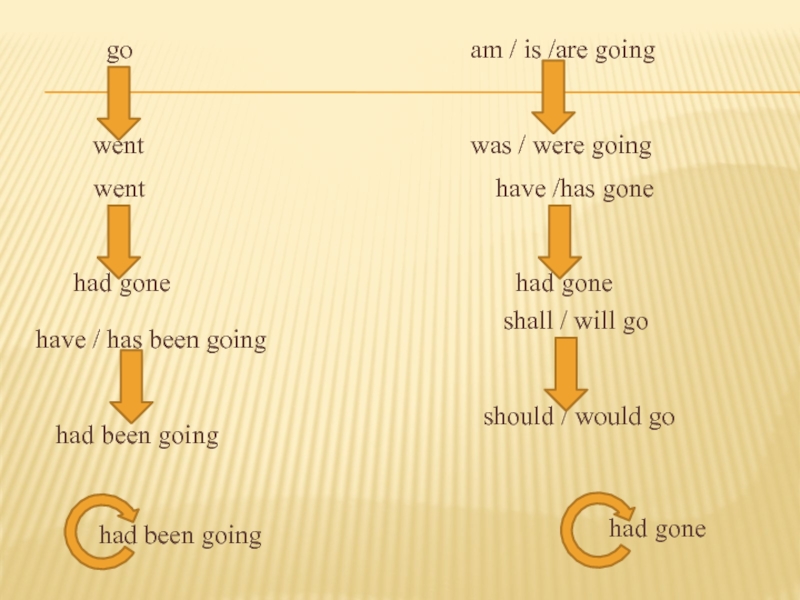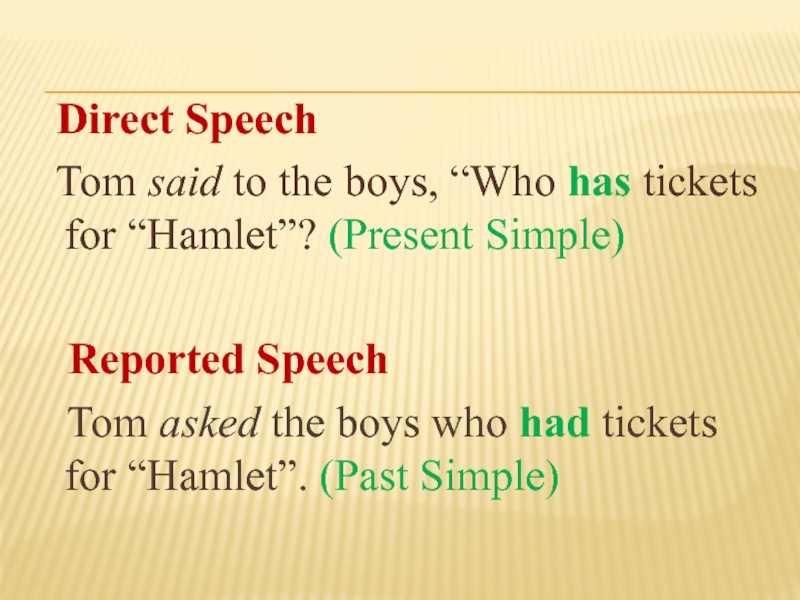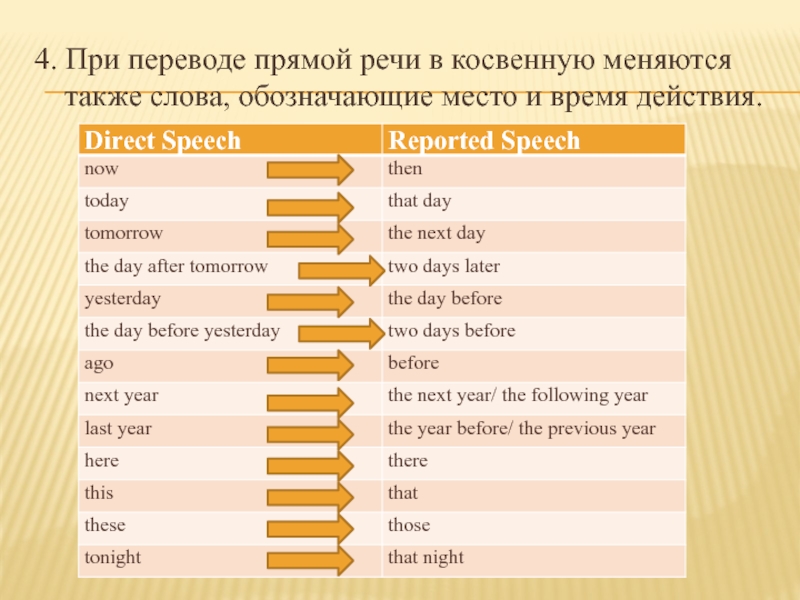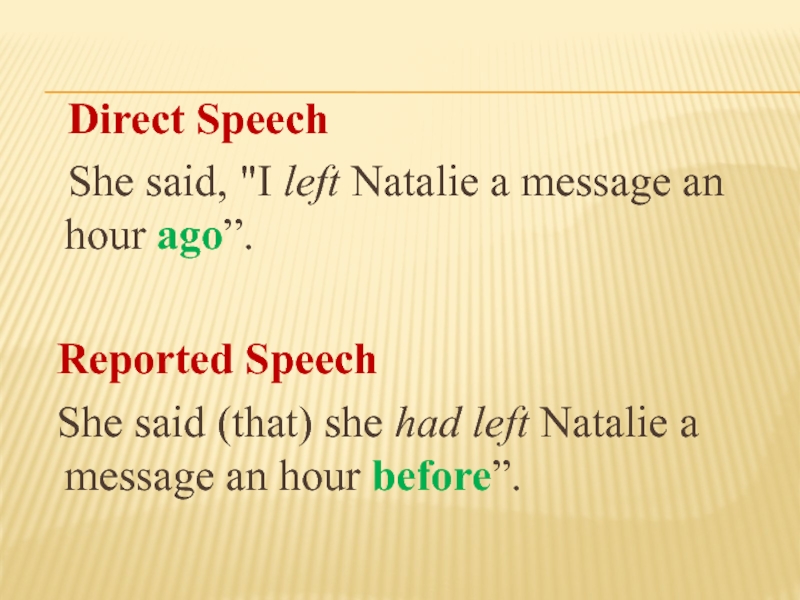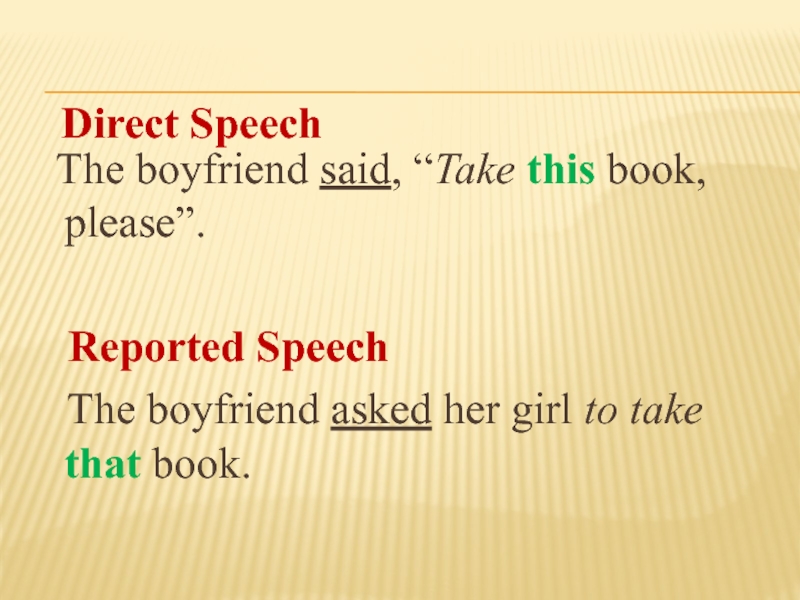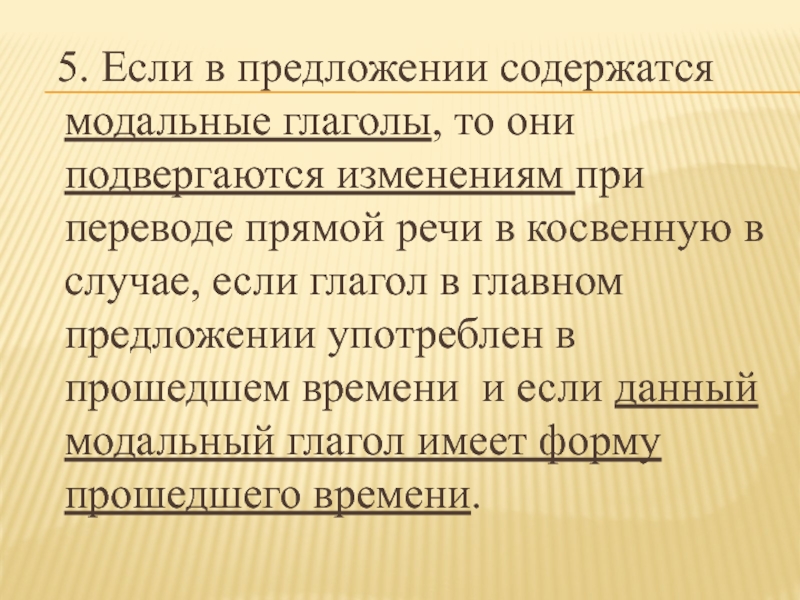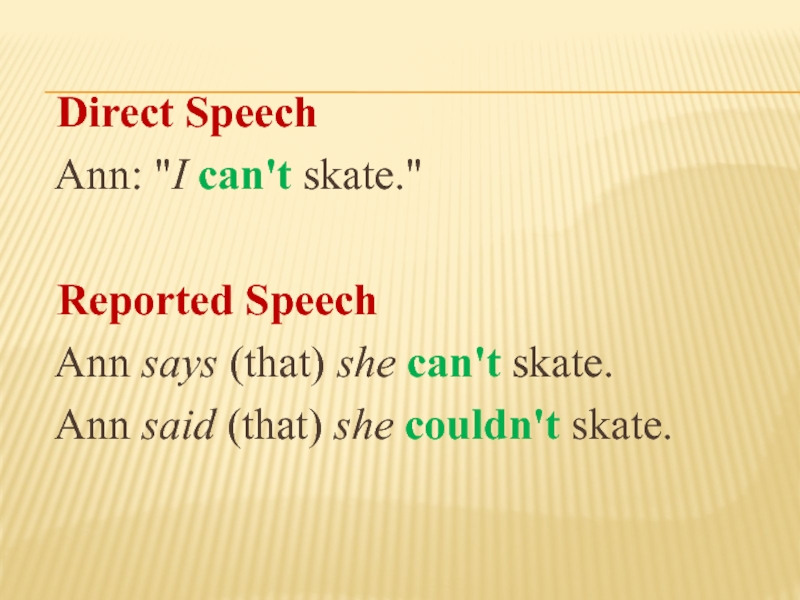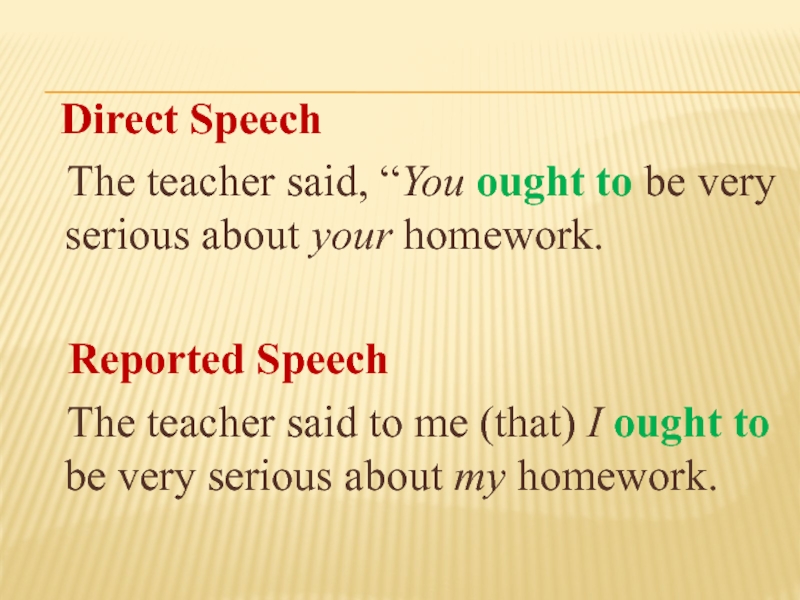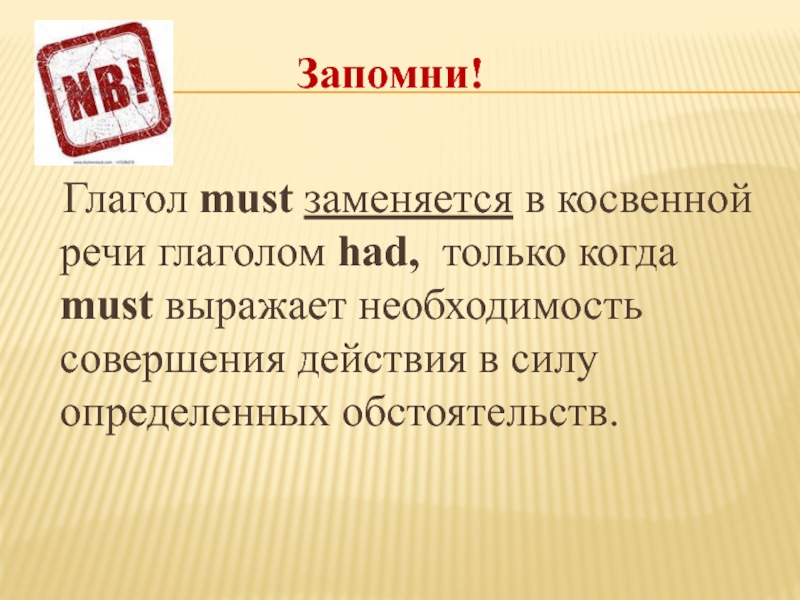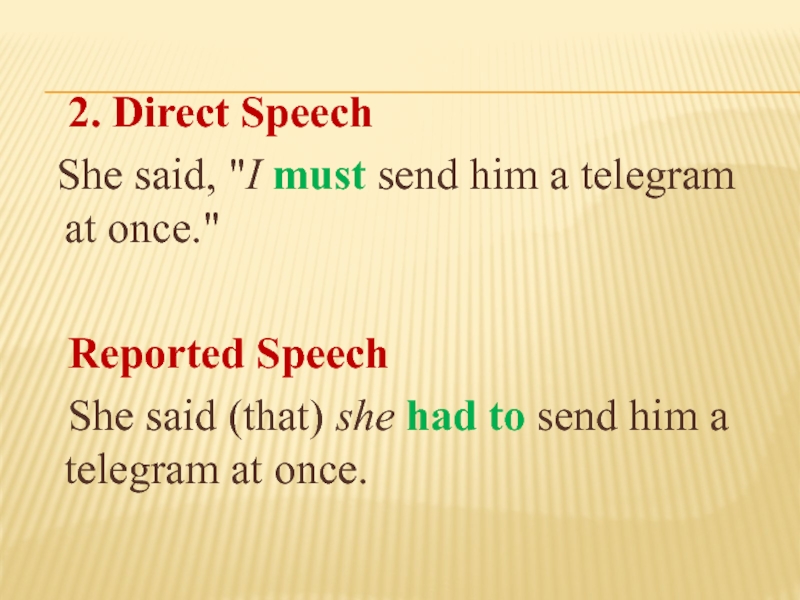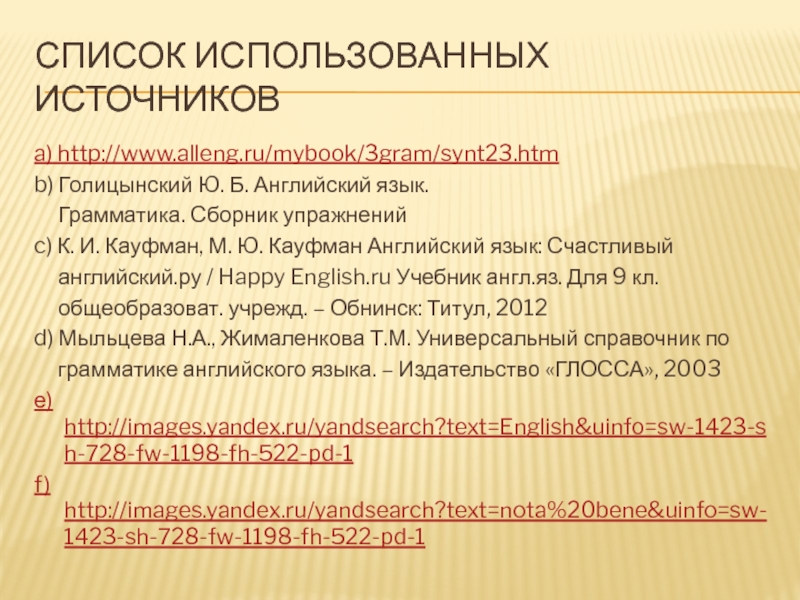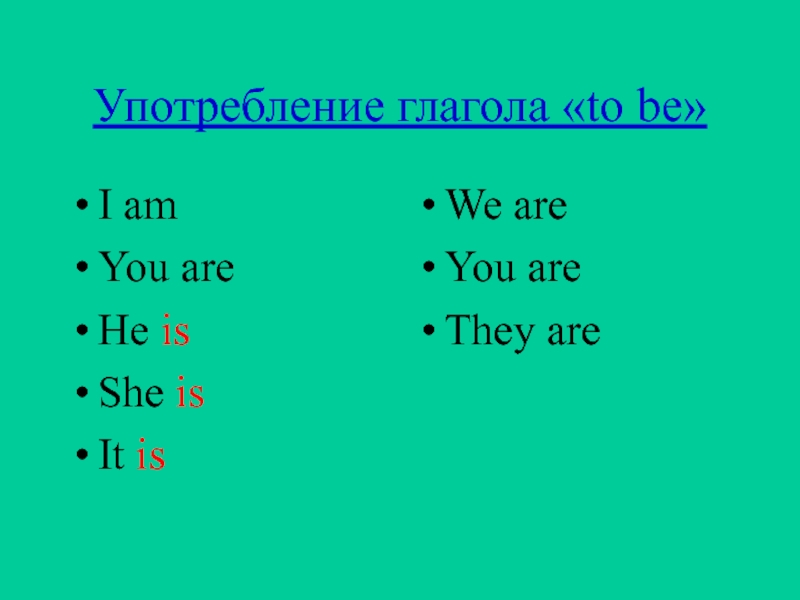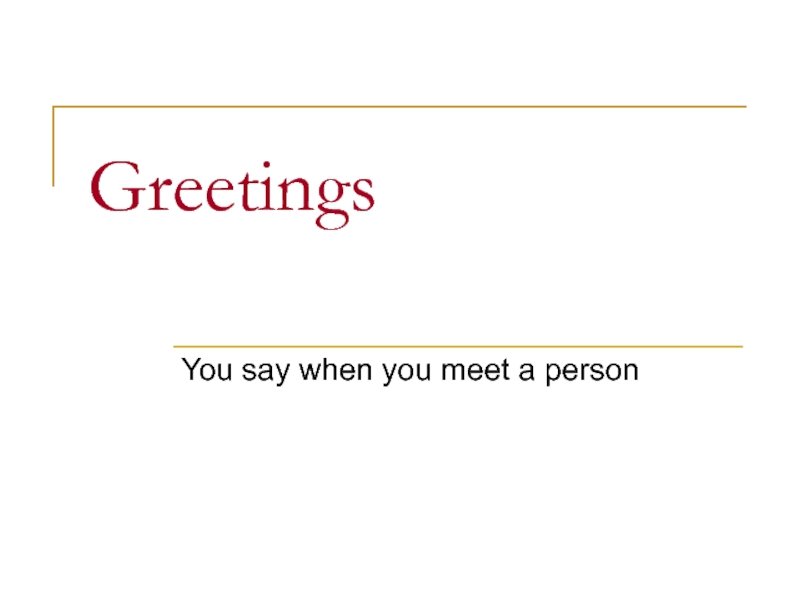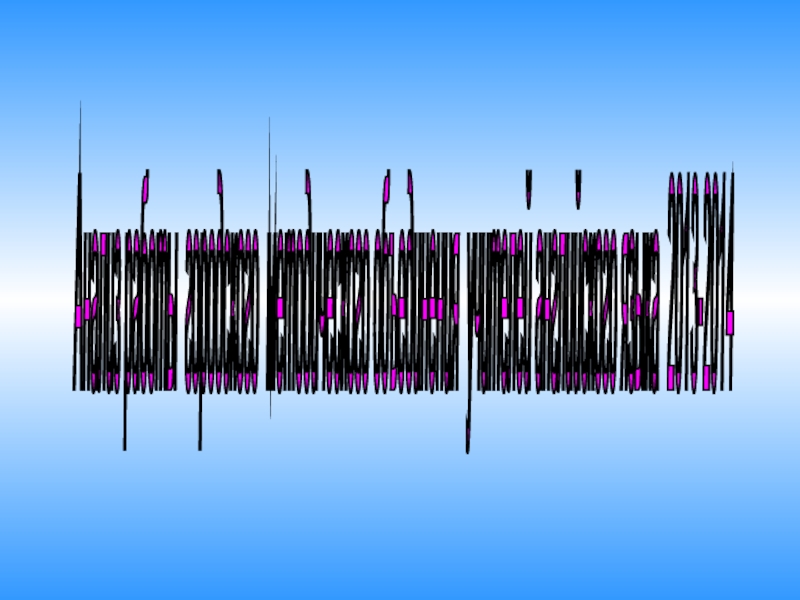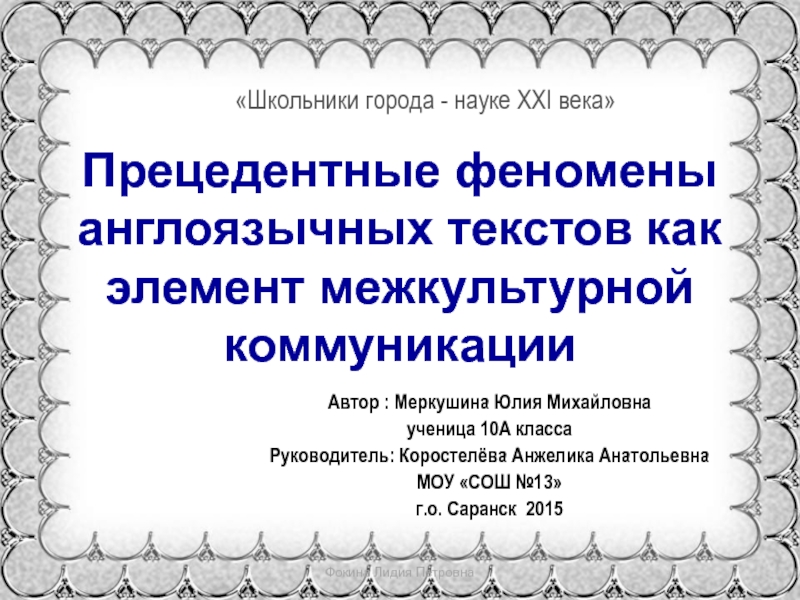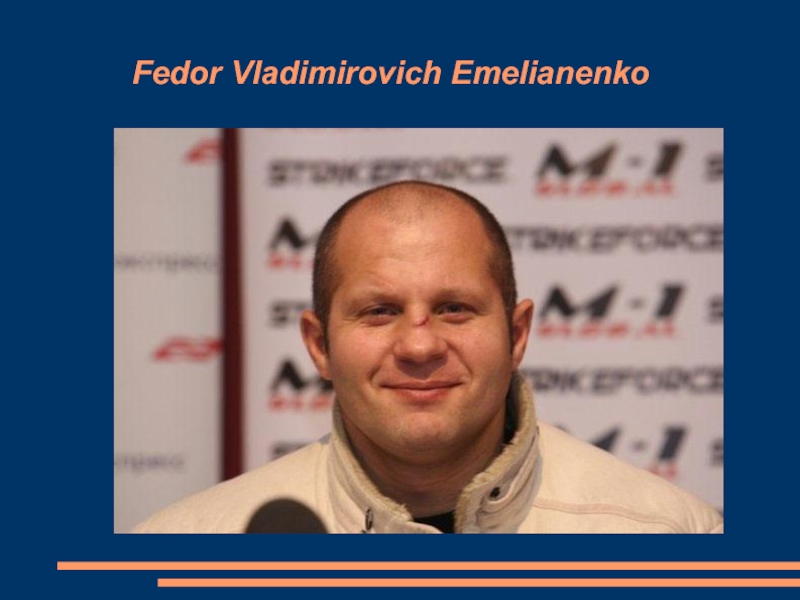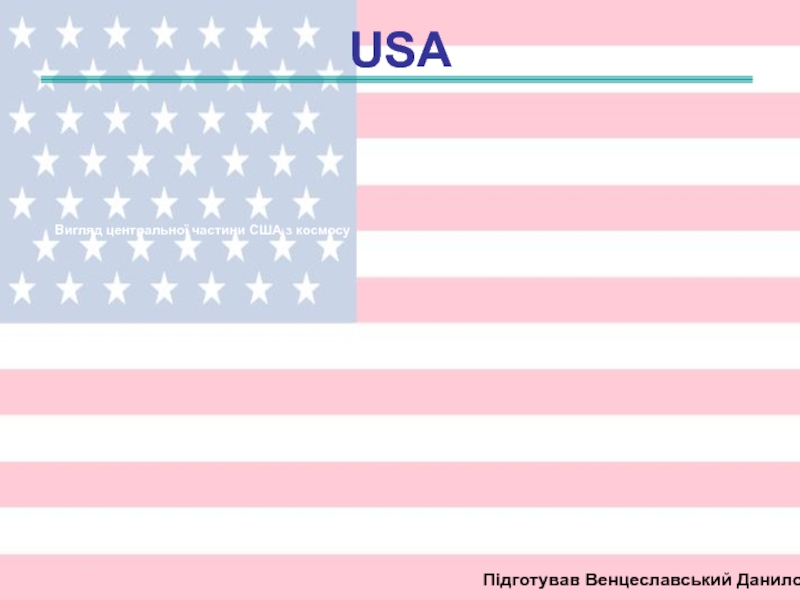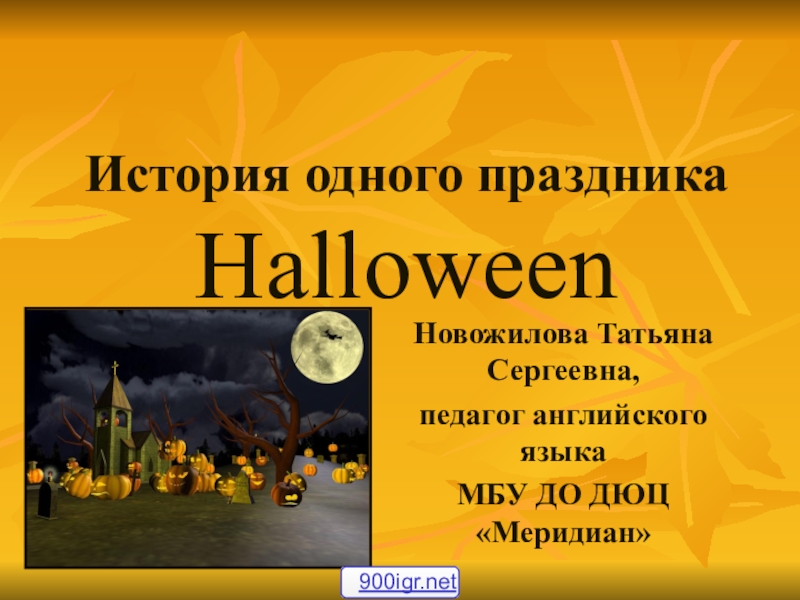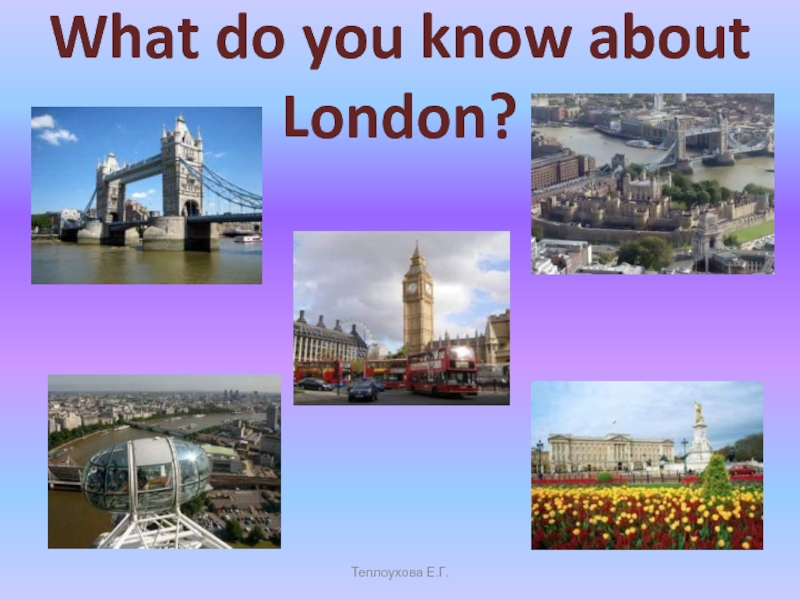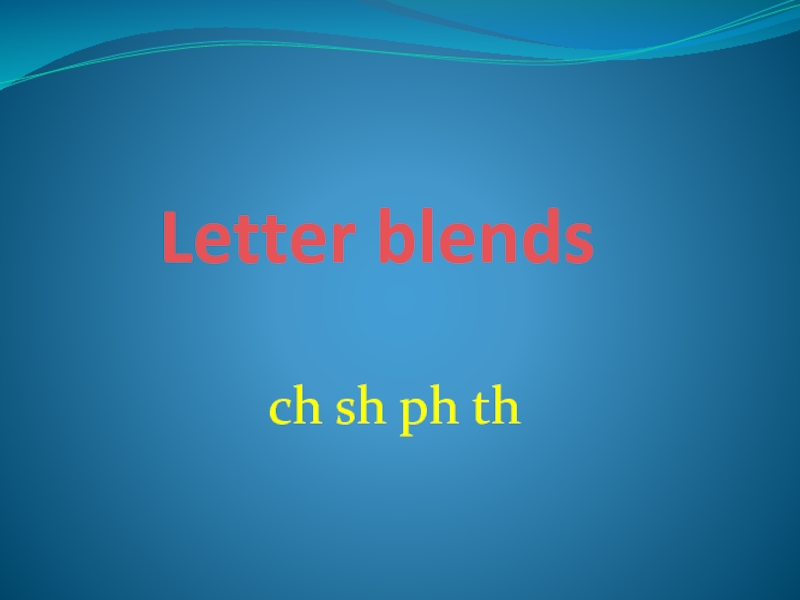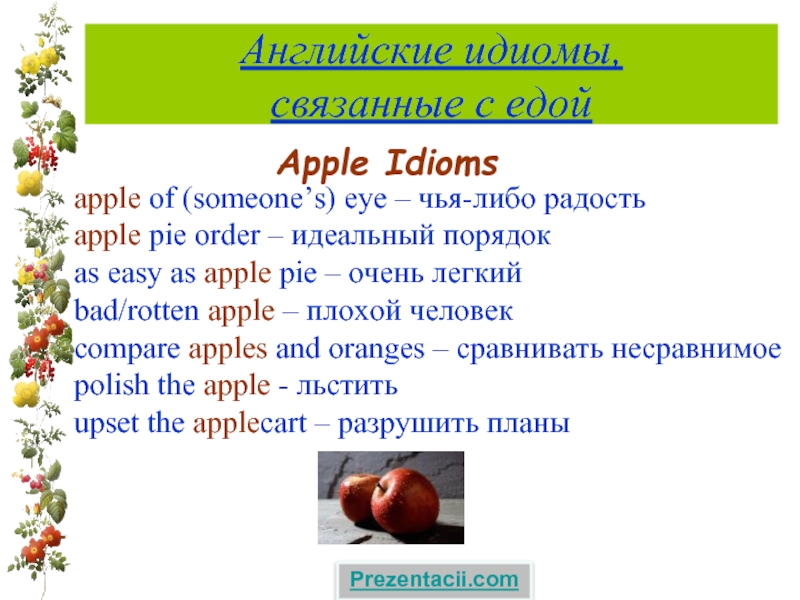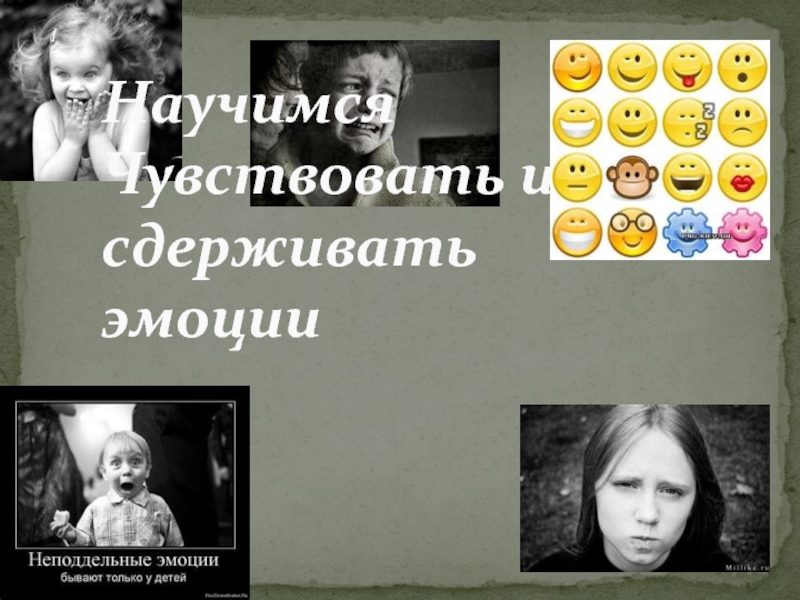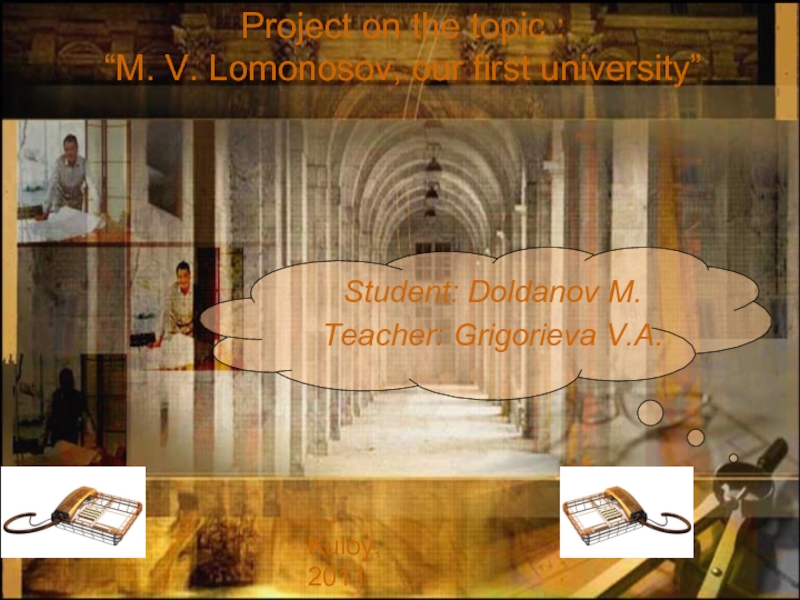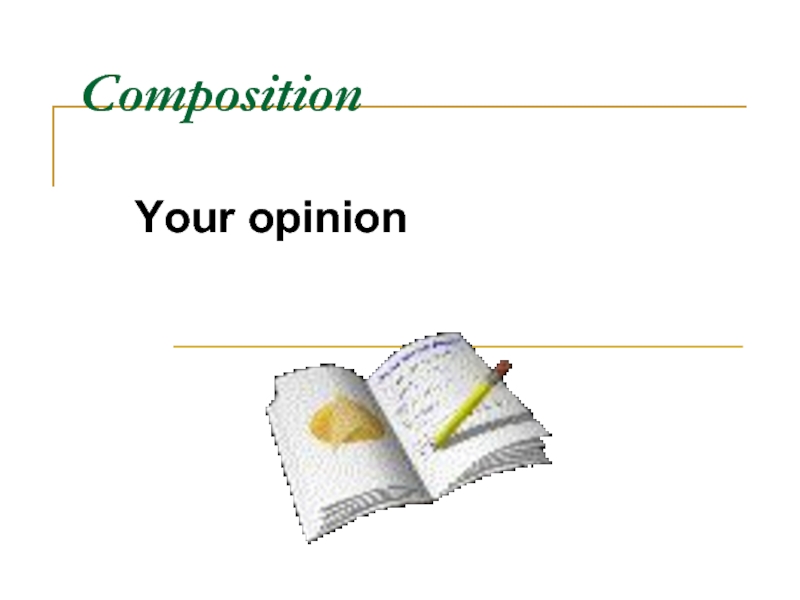Слайд 1Презентация к уроку английского языка по теме
“The Reported Speech
(general information)”
(8 – 9 классы)
Подготовлена
учителем английского языка
МБОУ СОШ п.
Солидарность
Елецкого муниципального района
Липецкой области
Кирсановой Натальей Николаевной
Слайд 2
Речь какого-нибудь лица, передаваемая буквально так,
как она была произнесена, называется прямой речью (direct speech).
Речь,
передаваемая не слово в слово, а только по содержанию, в виде дополнительных придаточных предложений, называется косвенной речью (reported speech).
Слайд 3
Direct Speech
She says, "I phone my
friends every day". (утвердительное предложение)
Reported Speech
She says (that) she phones her friends every day.
Слайд 4 Direct Speech
The grandfather says to Mary,
“What mark did you get at school?”
(вопросительное предложение)
Reported Speech
The grandfather asks Mary what mark she had got at school.
Слайд 5
Direct Speech
The teacher said to the
pupils, "Don't open your books.“ (просьба / приказ)
Reported
Speech
The teacher told the pupils not to open your books.“
Слайд 6 При переводе предложения из прямой речи в косвенную
соблюдаются следующие правила:
1. Запятая, отделяющая слова, вводящие прямую речь,
опускается. Кавычки не употребляются.
Слайд 7
2. Все личные и притяжательные местоимения изменяются по смыслу.
Direct
Speech
Bob said, “I am learning Spanish.”
Reported Speech
Bob said (that) he was learning Spanish.
Слайд 8
Direct Speech
He said, "I don't
like to watch cartoons.”
Reported Speech
He said (that) he didn’t like to watch cartoons.
Слайд 9
Direct Speech
The manager says to Mike:
“Does your father work at a factory?”
Reported Speech
The manager asks Mike if his father works at a factory.
Слайд 10
Direct Speech
Kate said to her grandmother,
"Help me to cook the soup, please!“
Reported
Speech
Kate asked her grandmother to help her to cook the soup.
Слайд 11
3. При переводе из прямой речи в косвенную
в первую очередь следует обращать внимание на грамматическое время глагола
в главном предложении.
(She says…/ She said…)
Слайд 12
а) Если глагол, вводящий косвенную речь, стоит в одном из
настоящих или будущих времен, грамматическое время глагола в косвенной речи
не меняется.
Слайд 13
Direct Speech
Не says, "I can't
remember where I've put the tickets. (Present Simple)
Reported
Speech
Не says (that) he can't remember where he's put the tickets."
(Present Simple)
Слайд 14
Direct Speech
He has already said,
"I can't remember where he's put the tickets. (Present
Perfect)
Reported Speech
He has already said (that) he can't remember where I've put the tickets.“ (Present Perfect)
Слайд 15
Direct Speech
If you ask him
about the tickets, he'll say,
"I can't remember where I've put the tickets."
(Future Simple)
Reported Speech
If you ask him about the tickets, he'll say (that)
he can't remember where he's put the tickets.
(Future Simple)
Слайд 16 b) Если глагол, вводящий косвенную речь, стоит в одном
из прошедших времен, глагол в придаточном предложении косвенной речи употребляется
обязательно в одном из прошедших времен. При этом соблюдается правило согласования времен.
go
went
went
had gone
have / has been going
had been going
am / is /are going
was / were going
have /has gone
had gone
shall / will go
should / would go
had gone
had been going
Слайд 19
Direct Speech
Tom said to the boys, “Who
has tickets for “Hamlet”? (Present Simple)
Reported Speech
Tom asked the boys who had tickets for “Hamlet”. (Past Simple)
Слайд 20
Direct Speech
Mary said, “I will do it
after my arrival”. (Future Simple)
Reported Speech
Mary
said (that) she would do it after her arrival”.
(Future-in-the-Past Simple)
Слайд 21
Direct Speech
Sam said, “He didn’t get on
with his stepma”. (Past Simple)
Reported Speech
Sam
said (that) he hadn’t got on with his stepma. (Past Perfect)
Слайд 22 Правило согласования времен
не действует в следующих случаях:
1)
Если сказуемое в придаточном предложении выражает общеизвестное положение или факт:
The teacher told the children that the Earth is round. – Учитель сказал детям, что земля круглая.
Слайд 23 Правило согласования времен
не действует в следующих случаях:
2) Если в придаточном предложении указано время совершения действия:
Linda said (that) she called her doctor two hours ago. – Линда сказала, что она звонила доктору два часа назад.
Слайд 24 Правило согласования времен
не действует в следующих случаях:
3) В предложениях, в придаточных которых употребляется сослагательное наклонение:
He said that if he had time he would go to the pictures. – Он сказал, что, если бы у него было время, он сходил бы в кино.
Слайд 254. При переводе прямой речи в косвенную меняются также слова,
обозначающие место и время действия.
Слайд 26
Direct Speech
She said, "I left
Natalie a message an hour ago”.
Reported Speech
She said
(that) she had left Natalie a message an hour before”.
Слайд 27
Direct Speech
The teacher said, "Did
you read an English book last year?“
Reported Speech
The teacher asked me if I had read an English book the year before?“
Слайд 28
The boyfriend said, “Take this book, please”.
Reported
Speech
The boyfriend asked her girl to take that
book.
Direct Speech
Слайд 29 5. Если в предложении содержатся модальные глаголы, то они
подвергаются изменениям при переводе прямой речи в косвенную в случае,
если глагол в главном предложении употреблен в прошедшем времени и если данный модальный глагол имеет форму прошедшего времени.
Слайд 31
Direct Speech
Ann: "I can't skate."
Reported Speech
Ann says (that) she can't skate.
Ann said (that) she couldn't skate.
Слайд 32
Direct Speech
The teacher said, “You ought
to be very serious about your homework.
Reported Speech
The teacher said to me (that) I ought to be very serious about my homework.
Запомни!
Глагол must заменяется
в косвенной речи глаголом had, только когда must выражает необходимость совершения действия в силу определенных обстоятельств.
Слайд 34
1. Direct Speech
My mother said, “You
must consult a doctor”.
Reported Speech
My
mother said (that) I must consult a doctor.
Слайд 35
2. Direct Speech
She said, "I must send
him a telegram at once."
Reported Speech
She said (that) she had to send him a telegram at once.
Слайд 36Список использованных источников
a) http://www.alleng.ru/mybook/3gram/synt23.htm
b) Голицынский Ю. Б. Английский язык.
Грамматика. Сборник упражнений
c) К. И. Кауфман, М. Ю.
Кауфман Английский язык: Счастливый
английский.ру / Happy English.ru Учебник англ.яз. Для 9 кл.
общеобразоват. учрежд. – Обнинск: Титул, 2012
d) Мыльцева Н.А., Жималенкова Т.М. Универсальный справочник по
грамматике английского языка. – Издательство «ГЛОССА», 2003
е) http://images.yandex.ru/yandsearch?text=English&uinfo=sw-1423-sh-728-fw-1198-fh-522-pd-1
f) http://images.yandex.ru/yandsearch?text=nota%20bene&uinfo=sw-1423-sh-728-fw-1198-fh-522-pd-1
